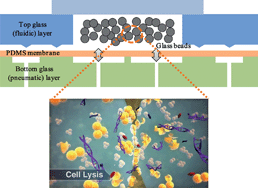Miniaturized bead-beating device to automate full DNA sample preparation processes for Gram-positive bacteria†
Abstract
We have developed a miniaturized bead-beating device to automate nucleic acids

* Corresponding authors
a
Bio Lab, Samsung Advanced Institute of Technology (SAIT), Samsung Electronics Co., Ltd., Republic of Korea
E-mail:
mythos.kim@samsung.com
Fax: +82-31-280-8277
Tel: +82-31-280-6939
b
Interdisciplinary Program of Bioengineering, Seoul National University, Republic of Korea
E-mail:
sky4u@snu.ac.kr
Fax: +82-2-880-9103
Tel: +82-2-880-9103
c School of Mechanical and Aerospace Engineering, Institute of Advanced Machinery and Design (IAMD), Seoul National University, Republic of Korea
d Department of Bio and Brain Engineering, College of Life Science and Bioengineering, KAIST, 291 Daehak-ro, Yuseong-gu, Daejeon, Republic of Korea
We have developed a miniaturized bead-beating device to automate nucleic acids

 Please wait while we load your content...
Something went wrong. Try again?
Please wait while we load your content...
Something went wrong. Try again?
K. Hwang, S. H. Kwon, S. Jung, H. Lim, W. Jung, C. Park, J. Kim, K. Suh and N. Huh, Lab Chip, 2011, 11, 3649 DOI: 10.1039/C1LC20692C
To request permission to reproduce material from this article, please go to the Copyright Clearance Center request page.
If you are an author contributing to an RSC publication, you do not need to request permission provided correct acknowledgement is given.
If you are the author of this article, you do not need to request permission to reproduce figures and diagrams provided correct acknowledgement is given. If you want to reproduce the whole article in a third-party publication (excluding your thesis/dissertation for which permission is not required) please go to the Copyright Clearance Center request page.
Read more about how to correctly acknowledge RSC content.
 Fetching data from CrossRef.
Fetching data from CrossRef.
This may take some time to load.
Loading related content
